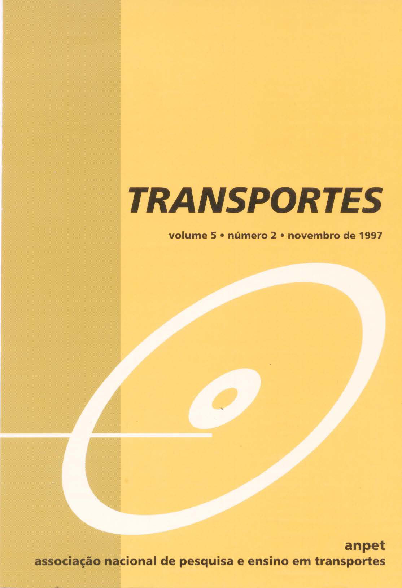DETERMINAÇÃO DA CAPACIDADE E NÍVEL DE SERVIÇO EM INTERSEÇÕES RODOVIÁRIAS ATRAVÉS DE SIMULAÇÃO
DOI:
https://doi.org/10.14295/transportes.v5i2.280Abstract
Este trabalho descreve o uso de um simulador na analise do impacto de veículos pesados na capacidade e no nível de serviço de interseções rodoviárias não semaforizadas. O impacto na capacidade é medido através da determinação de fatores de equivalência veicular, enquanto que a avaliação do nível de serviço da interseção baseia-se nos tempos médios de espera dos veículos durante as manobras de cruzamento. Os resultados obtidos mostram que os veículos que causam maior impacto na operação das interseções são os caminhões articulados, devido ao seu comprimento, e os caminhões médios, devido a sua menor relação potência/peso. Os fatores de equivalência obtidos são, em geral, maiores que equivalentes veiculares adotados pelo HCM de 1994, mostrando a necessidade de se desenvolver um método para analise de interseções não semaforizadas mais adequado as condições nacionais.
ABSTRACT
This paper describes the use of a simulator to analyze heavy vehicle impacts on capacity and level of service of rural unsignalized intersections. The impact on capacity is measured d by the do termination of equivalence factors and the level of service a assessment is based on average delay crossing times. The results indicate that the two vehicle classes responsible for the greatest intact are articulated trucks (due to their length) and medium-sized trucks, because of their poor power-to-weight ratio. The equivalence factors obtained are greater than those shown in the 1994 HCM, demonstrating the need for development of an unsignalized intersection analysis method more adequate to the Brazilian operational and vehicle conditions.
Downloads
Downloads
Published
How to Cite
Issue
Section
License
Authors who submit papers for publication by TRANSPORTES agree to the following terms:
- The authors retain the copyright and grant Transportes the right of first publication of the manuscript, without any financial charge, and waive any other remuneration for its publication by ANPET.
- Upon publication by Transportes, the manuscript is automatically licensed under the Creative Commons License CC BY 4.0 license. This license permits the work to be shared with proper attribution to the authors and its original publication in this journal.
- Authors are authorized to enter into additional separate contracts for the non-exclusive distribution of the version of the manuscript published in this journal (e.g., publishing in an institutional repository or as a book chapter), with recognition of the initial publication in this journal, provided that such a contract does not imply an endorsement of the content of the manuscript or the new medium by ANPET.
- Authors are permitted and encouraged to publish and distribute their work online (e.g., in institutional repositories or on their personal websites) after the editorial process is complete. As Transportes provides open access to all published issues, authors are encouraged to use links to the DOI of their article in these cases.
- Authors guarantee that they have obtained the necessary authorization from their employers for the transfer of rights under this agreement, if these employers hold any copyright over the manuscript. Additionally, authors assume all responsibility for any copyright infringements by these employers, releasing ANPET and Transportes from any responsibility in this regard.
- Authors assume full responsibility for the content of the manuscript, including the necessary and appropriate authorizations for the disclosure of collected data and obtained results, releasing ANPET and Transportes from any responsibility in this regard.










